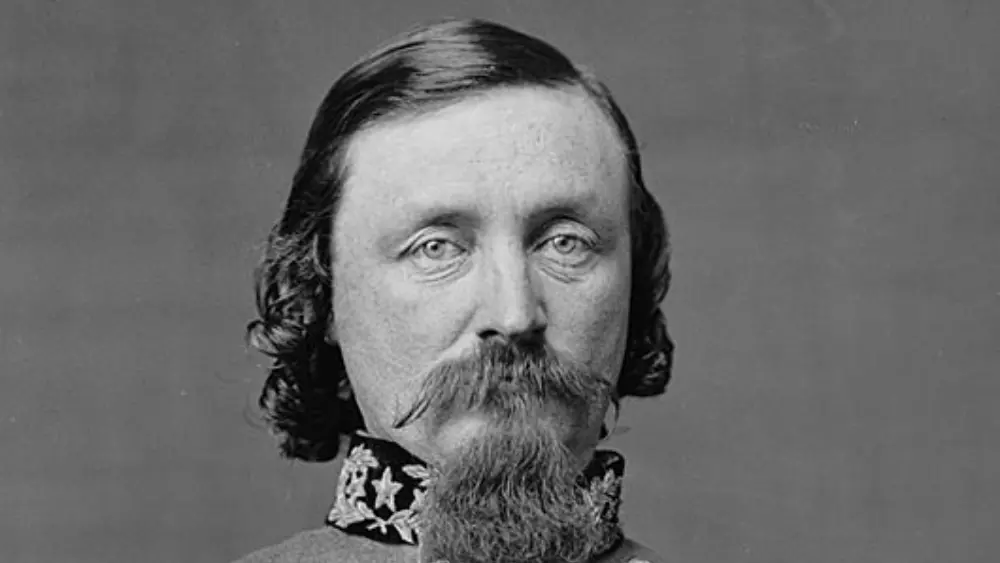Confederate General George Pickett, during the American Civil War, etched his name into history through his role in the infamous Pickett’s Charge at the Battle of Gettysburg. Born on January 16, 1825, in Richmond, Virginia, Pickett’s military career and legacy would become synonymous with one of the most pivotal moments of the Civil War.
Early Life and Military Education
George Pickett’s early life and military education played a pivotal role in shaping the trajectory of his career, ultimately propelling him to prominence on the battlefields of the Civil War. Born into a prominent Virginia family in 1825, Pickett’s upbringing was characterized by the cultural and social influences of the Southern aristocracy. His early exposure to the military lifestyle and the ethos of the antebellum South instilled in him a sense of duty and honor that would become defining elements of his character.
Pickett’s formal military education took place at the United States Military Academy at West Point, where he enrolled in 1841. Graduating in 1846, he belonged to a class that would later become renowned as the “Class of ’46,” producing several notable Civil War generals. Pickett’s years at West Point not only provided him with a rigorous education in military tactics and strategy but also exposed him to the camaraderie and competition that would shape his relationships with fellow officers on the battlefield. His experiences at West Point laid the foundation for the leadership skills and military prowess that would come to the fore during the tumultuous years of the Civil War.
George Pickett: Mexican-American War and Interwar Period
George Pickett’s experiences in the Mexican-American War marked a crucial phase in his military career, providing a platform for the emergence of his leadership skills. During this conflict, he distinguished himself as a capable and valiant officer, earning commendations for his service. Pickett’s performance in the Mexican-American War foreshadowed the leadership qualities that would come to define his role in the Civil War, showcasing his strategic acumen and determination on the battlefield.
The interwar period saw Pickett continue to hone his military skills while serving on the western frontier. His time in the U.S. Army during these years further solidified his reputation as a charismatic and capable officer. Pickett’s experiences in the interwar period, marked by engagements with Native American tribes and the challenges of maintaining order on the frontier, contributed to the development of his leadership style and tactical proficiency. As he navigated the complexities of the western frontier, Pickett continued to refine the skills that would later be tested in the crucible of the Civil War.
Civil War Service and Rise to Prominence
When the Civil War erupted, George Pickett aligned himself with the Confederacy, marking a significant chapter in his military career. His dedication to the Southern cause led him to play a crucial role in various campaigns, demonstrating his tactical prowess and leadership abilities on the battlefield. Notably, Pickett participated in the Peninsula Campaign and the Battle of Antietam, where his contributions garnered attention and contributed to his rising prominence within the Confederate Army.
Pickett’s reputation continued to grow, and he became widely recognized for his leadership during the war. His most enduring legacy would be forged during the Battle of Gettysburg in 1863. Pickett’s Charge, a daring but ultimately unsuccessful assault on the Union lines, would become one of the most iconic moments of the Civil War. Although the charge ended in significant Confederate casualties, Pickett’s leadership in this high-stakes engagement further solidified his place in history and made him a prominent figure in the annals of the Confederate military.
George Pickett: Pickett’s Charge at Gettysburg
The defining moment of George Pickett’s military career unfolded during the Battle of Gettysburg, a pivotal engagement in the American Civil War. Pickett was given a crucial role in the conflict when he was entrusted with leading a daring assault against the Union center on Cemetery Ridge, an action that would later be eternally memorialized as Pickett’s Charge. This ill-fated maneuver, which took place on July 3, 1863, marked a desperate attempt by the Confederates to break the Union lines. Despite the courage and determination displayed by the Confederate forces, Pickett’s Charge ultimately resulted in significant casualties and ended in failure, symbolizing a turning point in the course of the war.
Pickett’s Charge at Gettysburg is remembered as one of the most iconic and costly actions of the Civil War. The immense sacrifices made by the Confederate soldiers under Pickett’s command, coupled with the strategic significance of the battle, have made Pickett’s Charge a symbol of both the heroism and the harsh realities of warfare during this tumultuous period in American history. The failure of the assault had profound implications for the Confederacy, and the memory of Pickett’s Charge at Gettysburg remains a poignant chapter in the broader narrative of the Civil War.
Post-Gettysburg and Later Campaigns
After the setback at Gettysburg, George Pickett continued to serve in the Confederate Army, participating in various campaigns during the later stages of the Civil War. Despite his earlier prominence and leadership roles, the legacy of Pickett’s Charge cast a shadow over his military standing and personal reputation. The boldness and audacity that characterized his assault at Gettysburg were tempered by the sobering reality of the charge’s failure and the significant loss of life it incurred. As a result, Pickett faced challenges in regaining the trust and esteem he once held within the Confederate military hierarchy.
The memory of Gettysburg often overshadowed Pickett’s contributions in the later campaigns of the war. The toll of the conflict, both in terms of strategic losses and the depletion of resources, added to the immense challenges faced by the Confederate forces. Despite the complexities of the post-Gettysburg period, Pickett continued to fulfill his military duties with determination, yet the specter of his most famous charge remained a defining aspect of his legacy during and after the Civil War.
George Pickett: Post-War Years and Legacy
In the post-war years, George Pickett confronted the challenges of readjusting to civilian life. His prominent military career did not shield him from the difficulties many Confederate Veterans faced in the aftermath of the conflict. Pickett held various positions, reflecting a pragmatic approach to building a life beyond the battlefield. Among these roles, he served as a commissioner of fisheries in Virginia, contributing to the state’s post-war recovery efforts. However, the scars of war, both physical and emotional, took a toll on Pickett’s health.
George Pickett passed away on July 30, 1875, marking the end of a life that had witnessed both the heights of military command and the depths of the Civil War’s aftermath. While his post-war years may not have mirrored the glory of his earlier military career, Pickett’s legacy endured, shaped by his role in defining one of the war’s most iconic moments at Gettysburg. The name Pickett became synonymous with bravery and tragedy, and despite the controversies surrounding his charge, his contributions to the Confederate cause and his enduring place in Civil War history ensured that his legacy would persist long after his passing.
Controversies and Historical Interpretations
George Pickett’s legacy is inseparable from the controversies that surround his pivotal role in the Battle of Gettysburg. The failure of Pickett’s Charge has been the subject of extensive historical debate, with scholars and historians offering varying interpretations of the events leading up to and during this iconic moment in the Civil War. Questions have persisted regarding the planning, execution, and overall strategic merit of Pickett’s Charge, with some attributing its failure to tactical shortcomings, inadequate support, or larger systemic issues within the Confederate command structure.
Historical interpretations of Pickett’s role in the charge have evolved over time, reflecting shifting perspectives on the broader context of the Civil War. Some portray Pickett as a courageous but ill-fated commander, while others question his judgment and leadership decisions. The controversies surrounding Pickett’s Charge have contributed to a nuanced understanding of the challenges faced by Confederate commanders during the Civil War and the complexities of battlefield decision-making. As historians continue to scrutinize the events at Gettysburg, Pickett’s legacy remains entwined with the ongoing exploration of this critical moment in American history.

George Pickett: Symbol of Lost Cause Mythology
George Pickett, despite the controversies and the failure of his charge at Gettysburg, emerged as a symbolic figure within the Lost Cause mythology that sought to romanticize the Confederate struggle during and after the Civil War. The Lost Cause ideology, prevalent in the post-war South, idealized the Southern cause as a noble but doomed effort, emphasizing states’ rights and downplaying the role of slavery in the conflict. Pickett, with his charismatic leadership and association with one of the war’s most iconic moments, became a poignant symbol of the perceived valor and sacrifice of the Confederate forces.
Memorials and monuments dedicated to George Pickett, including the famous cyclorama depicting Pickett’s Charge at Gettysburg, contribute to the perpetuation of his legacy within Southern memory. These physical commemorations not only memorialize Pickett but also serve as symbolic expressions of the Lost Cause narrative, reinforcing a particular interpretation of the Civil War that aligns with the values and sentiments of the post-war South. Despite the complexities of Pickett’s historical role, his image endures in the cultural landscape as a figure emblematic of a romanticized version of Southern heritage, as shaped by the Lost Cause mythology.




